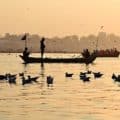Maha Shivaratri is a Hindu festival celebrated in the honor of Shiva. You may say that it marks the day of the marriage of Shiva. As per the Hindu calendar, Shivaratri happens in the lunisolar of the late winter it can be 21st February/March. In other words, Maha Shivaratri means “The biggest night of Shiva”.
It is the most important festival of Hindus and it gives you the power to fight darkness and ignorance. The believers of Shiva remember him by Chanting prayers, meditating, having fast and few people dress up in the attire of Shiva and perform the dance Bam Bam Bhole. Ardent devotees don’t sleep at night and keep chanting “Om Namah Shivay” in the temple. Some devotees go on a pilgrimage to Jyotirlingams.
The fascinating thing about it that it is celebrated in the late night, while most of the Hindu Festivals are celebrated in the day time. This festival is mostly notable for the Shiva dance, fasting, and meditation of Shiva. The program includes Jaagaran, All night prayers and chanting “Om Namah Shivay”. It is a festival whose date is not known to anyone but it happens before the arrival of summer.
History of Maha Shivaratri
The festival is mentioned in the Puranas i.e. a manuscript which says how is the festival originated. During Samudra Manthan, a poison emerged from the ocean. The poison was capable of destroying the whole world, the gods and demons ran to Lord Shiva for help. To protect the world Lord Shiva drank the poison but instead of swallowing it he stuck it in his throat.
This is how his throat turned blue after which he was named Neelkantha. We can say that Shivaratri is the celebration when Shiva saved the world. According to another great legend, this is a night when Shiva performs a heavenly dance of creation, preservation, and destruction. There are different legends that state different origination of Maha Shivaratri.
The most significant part of this festival is the dance tradition which has historical roots. It has served as historical confluence to the artist for dance festivals at the Hindu temples of Konark, Khajuraho, and Chidambaram. Different events take place at different temples. The most famous event is the Natyanjali which happens in Chidambaram temple, in other words, it is also called “Natya Shastra”. The Tamilians refer to it as “worshipping with dance”.
The Tantra
The priest or the guru awakened his consciousness at the material level of existence on this day. As per the Tantra in this stage, there is no objection and our mind is fully transformed. The meditator easily transforms time and space. It is one of the brightest nights when someone attains the stage of Nirvana.
Maha Shivaratri Celebration in different parts of the world
Maha Shivaratri in India
- Maha Shivaratri in Tiruvannamalai- Tamilians celebrate the festival vastly in Annamalai temple which is located at Tiruvannamalai. The way Tamilians worship is known as “Giri Pradakshina”, it is a 14 km walk without shoes around Lord Shiva’s temple on the hilltop.
- Maha Shivaratri in Varanasi- In Varanasi, there is a huge craze in Shivaratri. The devotees worship the Ganga River in the evening and the prayer fulfills their wishes whatever they want from Lord Shiva. They also serve as a site for fairs where you get the holy Prasad of Lord Shiva.
- Maha Shivaratri in Andhra Pradesh- Mostly Shivaratri in Andhra Pradesh are held at Mallaya, Gutta which is near Kambhalapalle. These are special pujas that are held at the Pancharamas of Amaravati and many other places. The devotees visit the special pujas at Srikalahasti, Mahanadi, Yaganti, and others.
- Maha Shivaratri in Mandi- The most famous place for Shivaratri in Mandi is the town fair. There is a strange belief that the gods are bulk to gather here on the night of Shivaratri. The town transforms heavenly when all the devotees gather together.
- Maha Shivaratri in Kashmir- The Kashmir Brahmins celebrate the festival and it is known as Herath. In other words, Herath can be referred to as “Night of Harra”. In Kashmir, Shivaratri is celebrated in the 13th dark half-night of February-March but not on 14th. The reason behind this is the ritual of flame linga. In Tantric text, it has been described that his power or his energy is a part of Tantric worship. There is a ceremony where the pot full of water is filled representing the Tantra with walnuts.
- Maha Shivaratri in West Bengal- In Bengal, it is mostly observed in unmarried girls who are looking for a perfect life partner. They seek their bleedings by visiting Tarakeshwar.
- Maha Shivaratri in Gujarat- In Gujarat, the Shivaratri Mela is held in Junagarh where there is a place called Murghi Kund. Bathing inside that place is considered the holiest thing in Gujarat. It is said that Lord Mahadev once use to bath there.
Maha Shivaratri in Nepal
In India, Shivaratri might or might not be considered a holiday. But in Nepal, it is declared a national holiday and celebrated hugely in temples all over the country. Devotees gather in thousands at the Pashupatinath Temple where there is a Shiv Shakti Peeth. Rituals are performed all over the country.
They bring various artists from different classical music and form of dances. The married women pray for the long-living of their husbands and the unmarried women pray for a perfect life partner. The best thing is that in Nepal Shiva is worshipped as their First teacher who can raise divine.
Maha Shivaratri in Pakistan
Most of Hindus who are in Pakistan visit the Shiva temple during Shivaratri. The crucial part is three long day Shivaratri festival in Umarkot Shiv Mandir. It is attended by 2 lakhs of people. The expenses are incurred by Pakistan Hindu panchayat. When Hindus cremate dead the ashes are kept till Shivaratri immersing it inside the holy water is the most sacred thing.
Summing up
So we have known that Maha Shivaratri is not only famous in India but also in other countries. People from different countries have known about this festival. This is a festival which is also common in foreign countries outside Asia where people follow the tradition and celebrate the festival.




